Land Use Change and Landscape Ecological Risk Prediction in Urumqi under the Shared Socio-Economic Pathways and the Representative Concentration Pathways (SSP-RCP) Scenarios
Abstract
:1. Introduction
2. Materials and Methods
2.1. Study Area
2.2. Data Source and Processing
2.3. Methods
2.3.1. SSP-RCP Scenarios
2.3.2. System Dynamics Model
2.3.3. Patch-Generation Land Use Simulation Model
2.3.4. Landscape Ecological Risk Assessment
3. Results
3.1. Land Use/Cover Change
3.1.1. Land Use Demand Prediction
3.1.2. Land Use Spatial Distribution Simulation
3.2. Landscape Ecological Risk Change
3.2.1. Spatial Distribution of Landscape Ecological Risk
3.2.2. Changing Trends in Landscape Ecological Risk
4. Discussion
4.1. Comprehensive Impacts on Landscape Ecological Risk
4.2. Recommendations for the Future Development of Urumqi
4.3. Strengths and Limitations
5. Conclusions
Author Contributions
Funding
Data Availability Statement
Acknowledgments
Conflicts of Interest
Abbreviations
| LUCC | Land use/cover change |
| CMIP6 | The Coupled Model Intercomparison Project Phase 6 |
| SD | System dynamics |
| PLUS | Patch-generation land use simulation |
| LERI | Landscape ecological risk index |
| GHG | Greenhouse gas |
| SSPs | The Shared Socioeconomic Pathways |
| RCPs | The Representative Concentration Pathways |
| ANN | Artificial neural network |
| CA | Cellular automata |
| CLUE-S | Conversion of land use and its effects at small regional extent |
| FLUS | Future land use simulation |
| LEAS | Land expansion analysis strategy |
| CARS | Cellular automata based on multi-type random patch seeds |
| GCMs | Global climate models |
| GDP | Gross domestic product |
| DEM | Digital elevation model |
| RGG | Annual rate of GDP growth |
| RPG | Annual rate of population growth |
| TC | Annual average surface temperature change |
| PC | Annual precipitation change |
| RC | Annual runoff change |
| VC | Annual average vegetation coverage change |
References
- Su, B.; Huang, J.; Mondal, S.K.; Zhai, J.; Wang, Y.; Wen, S.; Gao, M.; Lv, Y.; Jiang, S.; Jiang, T. Insight from CMIP6 SSP-RCP scenarios for future drought characteristics in China. Atmos. Res. 2021, 250, 105375. [Google Scholar] [CrossRef]
- Chen, C.; Gan, R.; Feng, D.; Yang, F.; Zuo, Q. Quantifying the contribution of SWAT modeling and CMIP6 inputting to streamflow prediction uncertainty under climate change. J. Clean. Prod. 2022, 364, 132675. [Google Scholar] [CrossRef]
- Arias, P.; Bellouin, N.; Coppola, E.; Jones, R.; Krinner, G.; Marotzke, J.; Naik, V.; Palmer, M.; Plattner, G.-K.; Rogelj, J. Climate Change 2021: The Physical Science Basis. Contribution of Working Group I to the Sixth Assessment Report of the Intergovernmental Panel on Climate Change; Technical Summary. In Proceedings of the Intergovernmental Panel on Climate Change AR6, Oberpfaffenhofen, Germany, 26 July–7 August 2021. [Google Scholar]
- Chen, J.; Shi, X.; Gu, L.; Wu, G.; Su, T.; Wang, H.-M.; Kim, J.-S.; Zhang, L.; Xiong, L. Impacts of climate warming on global floods and their implication to current flood defense standards. J. Hydrol. 2023, 618, 129236. [Google Scholar] [CrossRef]
- Kogan, F.; Adamenko, T.; Guo, W. Global and regional drought dynamics in the climate warming era. Remote Sens. Lett. 2013, 4, 364–372. [Google Scholar] [CrossRef]
- Barriopedro, D.; González-Herrero, S.; Trigo, R.M.; López-Bustins, J.A.; Oliva, M. Climate warming amplified the 2020 record-breaking heatwave in the Antarctic Peninsula. Commun. Earth Environ. 2022, 3, 122. [Google Scholar]
- Forbes, V.E.; Galic, N. Next-generation ecological risk assessment: Predicting risk from molecular initiation to ecosystem service delivery. Environ. Int. 2016, 91, 215–219. [Google Scholar] [CrossRef]
- Depietri, Y. The social–ecological dimension of vulnerability and risk to natural hazards. Sustain. Sci. 2020, 15, 587–604. [Google Scholar] [CrossRef]
- Peng, J.; Dang, W.; Liu, Y.; Zong, M.; Hu, X. Review on landscape ecological risk assessment. Acta Geogr. Sin 2015, 70, 664–677. [Google Scholar]
- Ayre, K.K.; Landis, W.G. A Bayesian approach to landscape ecological risk assessment applied to the Upper Grande Ronde Watershed, Oregon. Hum. Ecol. Risk Assess. 2012, 18, 946–970. [Google Scholar] [CrossRef]
- Cui, L.; Zhao, Y.; Liu, J.; Han, L.; Ao, Y.; Yin, S. Landscape ecological risk assessment in Qinling Mountain. Geol. J. 2018, 53, 342–351. [Google Scholar] [CrossRef]
- Xu, W.; Wang, J.; Zhang, M.; Li, S. Construction of landscape ecological network based on landscape ecological risk assessment in a large-scale opencast coal mine area. J. Clean. Prod. 2021, 286, 125523. [Google Scholar] [CrossRef]
- La Rosa, D.; Martinico, F. Assessment of hazards and risks for landscape protection planning in Sicily. J. Environ. Manag. 2013, 127, S155–S167. [Google Scholar] [CrossRef]
- Lin, Y.; Hu, X.; Zheng, X.; Hou, X.; Zhang, Z.; Zhou, X.; Qiu, R.; Lin, J. Spatial variations in the relationships between road network and landscape ecological risks in the highest forest coverage region of China. Ecol. Indic. 2019, 96, 392–403. [Google Scholar] [CrossRef]
- Xie, H.; Wen, J.; Chen, Q.; Wu, Q. Evaluating the landscape ecological risk based on GIS: A case-study in the Poyang lake region of China. Land Degrad. Dev. 2021, 32, 2762–2774. [Google Scholar] [CrossRef]
- Landis, W.G. Twenty years before and hence: Ecological risk assessment at multiple scales with multiple stressors and multiple endpoints. Hum. Ecol. Risk Assess. Int. J. 2003, 9, 1317–1326. [Google Scholar] [CrossRef]
- Lin, X.; Wang, Z. Landscape ecological risk assessment and its driving factors of multi-mountainous city. Ecol. Indic. 2023, 146, 109823. [Google Scholar] [CrossRef]
- Han, N.; Yu, M.; Jia, P. Multi-scenario landscape ecological risk simulation for sustainable development goals: A case study on the central mountainous area of Hainan Island. Int. J. Environ. Res. Public Health 2022, 19, 4030. [Google Scholar] [CrossRef]
- Bürgi, M.; Bieling, C.; von Hackwitz, K.; Kizos, T.; Lieskovský, J.; Martín, M.G.; McCarthy, S.; Müller, M.; Palang, H.; Plieninger, T. Processes and driving forces in changing cultural landscapes across Europe. Landsc. Ecol. 2017, 32, 2097–2112. [Google Scholar] [CrossRef]
- Wang, Z.; Li, X.; Mao, Y.; Li, L.; Wang, X.; Lin, Q. Dynamic simulation of land use change and assessment of carbon storage based on climate change scenarios at the city level: A case study of Bortala, China. Ecol. Indic. 2022, 134, 108499. [Google Scholar] [CrossRef]
- Cook, B.I.; Mankin, J.S.; Marvel, K.; Williams, A.P.; Smerdon, J.E.; Anchukaitis, K.J. Twenty-first century drought projections in the CMIP6 forcing scenarios. Earth’s Future 2020, 8, e2019EF001461. [Google Scholar] [CrossRef]
- Eyring, V.; Bony, S.; Meehl, G.A.; Senior, C.A.; Stevens, B.; Stouffer, R.J.; Taylor, K.E. Overview of the Coupled Model Intercomparison Project Phase 6 (CMIP6) experimental design and organization. Geosci. Model Dev. 2016, 9, 1937–1958. [Google Scholar] [CrossRef]
- Liao, W.; Liu, X.; Xu, X.; Chen, G.; Liang, X.; Zhang, H.; Li, X. Projections of land use changes under the plant functional type classification in different SSP-RCP scenarios in China. Sci. Bull. 2020, 65, 1935–1947. [Google Scholar] [CrossRef] [PubMed]
- Dong, N.; You, L.; Cai, W.; Li, G.; Lin, H. Land use projections in China under global socioeconomic and emission scenarios: Utilizing a scenario-based land-use change assessment framework. Glob. Environ. Chang. 2018, 50, 164–177. [Google Scholar] [CrossRef]
- Nath, B.; Wang, Z.; Ge, Y.; Islam, K.; Singh, R.P.; Niu, Z. Land use and land cover change modeling and future potential landscape risk assessment using Markov-CA model and analytical hierarchy process. ISPRS Int. J. Geo-Inf. 2020, 9, 134. [Google Scholar] [CrossRef]
- Wu, M.; Ren, X.; Che, Y.; Yang, K. A coupled SD and CLUE-S model for exploring the impact of land use change on ecosystem service value: A case study in Baoshan District, Shanghai, China. Environ. Manag. 2015, 56, 402–419. [Google Scholar] [CrossRef]
- Islam, K.; Rahman, M.F.; Jashimuddin, M. Modeling land use change using cellular automata and artificial neural network: The case of Chunati Wildlife Sanctuary, Bangladesh. Ecol. Indic. 2018, 88, 439–453. [Google Scholar] [CrossRef]
- Feng, Y.; Tong, X. Dynamic land use change simulation using cellular automata with spatially nonstationary transition rules. GISci. Remote Sens. 2018, 55, 678–698. [Google Scholar] [CrossRef]
- Jiang, W.; Chen, Z.; Lei, X.; Jia, K.; Wu, Y. Simulating urban land use change by incorporating an autologistic regression model into a CLUE-S model. J. Geog. Sci. 2015, 25, 836–850. [Google Scholar] [CrossRef]
- Liu, X.; Liang, X.; Li, X.; Xu, X.; Ou, J.; Chen, Y.; Li, S.; Wang, S.; Pei, F. A future land use simulation model (FLUS) for simulating multiple land use scenarios by coupling human and natural effects. Landsc. Urban Plan. 2017, 168, 94–116. [Google Scholar] [CrossRef]
- Liang, X.; Guan, Q.; Clarke, K.C.; Liu, S.; Wang, B.; Yao, Y. Understanding the drivers of sustainable land expansion using a patch-generating land use simulation (PLUS) model: A case study in Wuhan, China. Comput. Environ. Urban Syst. 2021, 85, 101569. [Google Scholar] [CrossRef]
- Rasmussen, L.V.; Rasmussen, K.; Reenberg, A.; Proud, S. A system dynamics approach to land use changes in agro-pastoral systems on the desert margins of Sahel. Agric. Syst. 2012, 107, 56–64. [Google Scholar] [CrossRef]
- Turner, B.L.; Lambin, E.F.; Reenberg, A. The emergence of land change science for global environmental change and sustainability. Proc. Natl. Acad. Sci. USA 2007, 104, 20666–20671. [Google Scholar] [CrossRef] [PubMed]
- Verburg, P.H. Simulating feedbacks in land use and land cover change models. Landsc. Ecol. 2006, 21, 1171–1183. [Google Scholar] [CrossRef]
- Huang, X.; Liu, J.; Peng, S.; Huang, B. The impact of multi-scenario land use change on the water conservation in central Yunnan urban agglomeration, China. Ecol. Indic. 2023, 147, 109922. [Google Scholar] [CrossRef]
- Wang, J.; Zhang, J.; Xiong, N.; Liang, B.; Wang, Z.; Cressey, E.L. Spatial and temporal variation, simulation and prediction of land use in ecological conservation area of Western Beijing. Remote Sens. 2022, 14, 1452. [Google Scholar] [CrossRef]
- Yao, J.; Yang, Q.; Chen, Y.; Hu, W.; Liu, Z.; Zhao, L. Climate change in arid areas of Northwest China in past 50 years and its effects on the local ecological environment. Chin. J. Ecol. 2013, 32, 1283. [Google Scholar]
- Li, H.; Li, Z.; Chen, Y.; Xiang, Y.; Liu, Y.; Kayumba, P.M.; Li, X. Drylands face potential threat of robust drought in the CMIP6 SSPs scenarios. Environ. Res. Lett. 2021, 16, 114004. [Google Scholar] [CrossRef]
- Li, P.; Zhang, R.; Xu, L. Three-dimensional ecological footprint based on ecosystem service value and their drivers: A case study of Urumqi. Ecol. Indic. 2021, 131, 108117. [Google Scholar] [CrossRef]
- GB/T21010-2017; Current Land Use Classification. National Standards of People’s Republic of China: Beijing, China, 2017.
- Li, M.; Luo, H.; Qin, Z.; Tong, Y. Spatial-Temporal Simulation of Carbon Storage Based on Land Use in Yangtze River Delta under SSP-RCP Scenarios. Land 2023, 12, 399. [Google Scholar] [CrossRef]
- Zhang, L.; Chen, X.; Xin, X. Short commentary on CMIP6 scenario model intercomparison project (ScenarioMIP). Adv. Clim. Chang. Res. 2019, 15, 519. [Google Scholar]
- Fan, M. Simulation of land cover change in Beijing-Tianjin-Hebei region based on different scenarios of SSP-RCP. Acta Geogr. 2022, 77, 228–244. [Google Scholar]
- Guo, H.; Cai, Y.; Li, B.; Tang, Y.; Qi, Z.; Huang, Y.; Yang, Z. An integrated modeling approach for ecological risks assessment under multiple scenarios in Guangzhou, China. Ecol. Indic. 2022, 142, 109270. [Google Scholar] [CrossRef]
- Men, D.; Pan, J. Ecological network identification and connectivity robustness evaluation in the Yellow River Basin under a multi-scenario simulation. Ecol. Model. 2023, 482, 110384. [Google Scholar] [CrossRef]
- Li, D.; Chang, Y.; Simayi, Z.; Yang, S. Multi-Scenario dynamic simulation of urban agglomeration development on the Northern Slope of the Tianshan Mountains in Xinjiang, China, with the goal of high-quality urban construction. Sustainability 2022, 14, 6862. [Google Scholar] [CrossRef]
- Mo, W.; Wang, Y.; Zhang, Y.; Zhuang, D. Impacts of road network expansion on landscape ecological risk in a megacity, China: A case study of Beijing. Sci. Total Environ. 2017, 574, 1000–1011. [Google Scholar] [CrossRef] [PubMed]
- Ran, P.; Hu, S.; Frazier, A.E.; Qu, S.; Yu, D.; Tong, L. Exploring changes in landscape ecological risk in the Yangtze River Economic Belt from a spatiotemporal perspective. Ecol. Indic. 2022, 137, 108744. [Google Scholar] [CrossRef]
- Zhao, Y.; Kasimu, A.; Liang, H.; Reheman, R. Construction and restoration of landscape ecological network in Urumqi city based on landscape ecological risk assessment. Sustainability 2022, 14, 8154. [Google Scholar] [CrossRef]
- Zhang, W.; Chang, W.J.; Zhu, Z.C.; Hui, Z. Landscape ecological risk assessment of Chinese coastal cities based on land use change. Appl. Geogr. 2020, 117, 102174. [Google Scholar] [CrossRef]
- Wang, H.; Liu, X.; Zhao, C.; Chang, Y.; Liu, Y.; Zang, F. Spatial-temporal pattern analysis of landscape ecological risk assessment based on land use/land cover change in Baishuijiang National nature reserve in Gansu Province, China. Ecol. Indic. 2021, 124, 107454. [Google Scholar] [CrossRef]
- Liu, Y.; Liu, Y.; Li, J.; Lu, W.; Wei, X.; Sun, C. Evolution of landscape ecological risk at the optimal scale: A case study of the open coastal wetlands in Jiangsu, China. Int. J. Environ. Res. Public Health 2018, 15, 1691. [Google Scholar] [CrossRef]
- Lockwood, J. Is potential evapotranspiration and its relationship with actual evapotranspiration sensitive to elevated atmospheric CO2 levels? Clim. Chang. 1999, 41, 193–212. [Google Scholar] [CrossRef]
- Mondal, S. Impact of climate change on soil fertility. In Climate Change and the Microbiome: Sustenance of the Ecosphere; Springer: Cham, Switzerland, 2021; pp. 551–569. [Google Scholar]
- Cassia, R.; Nocioni, M.; Correa-Aragunde, N.; Lamattina, L. Climate change and the impact of greenhouse gasses: CO2 and NO, friends and foes of plant oxidative stress. Front. Plant Sci. 2018, 9, 273. [Google Scholar] [CrossRef] [PubMed]
- Wei, T.; Shangguan, D.; Yi, S.; Ding, Y. Characteristics and controls of vegetation and diversity changes monitored with an unmanned aerial vehicle (UAV) in the foreland of the Urumqi Glacier No. 1, Tianshan, China. Sci. Total Environ. 2021, 771, 145433. [Google Scholar] [CrossRef]
- Ma, Z.; Sun, P.; Zhang, Q.; Zou, Y.; Lv, Y.; Li, H.; Chen, D. The characteristics and evaluation of future droughts across China through the CMIP6 multi-model ensemble. Remote Sens. 2022, 14, 1097. [Google Scholar] [CrossRef]
- Fan, X.; Duan, Q.; Shen, C.; Wu, Y.; Xing, C. Global surface air temperatures in CMIP6: Historical performance and future changes. Environ. Res. Lett. 2020, 15, 104056. [Google Scholar] [CrossRef]
- Sun, L.; Yu, H.; Sun, M.; Wang, Y. Coupled impacts of climate and land use changes on regional ecosystem services. J. Environ. Manag. 2023, 326, 116753. [Google Scholar] [CrossRef] [PubMed]
- Liu, H.; Liu, Y.; Wang, C.; Zhao, W.; Liu, S. Landscape pattern change simulations in Tibet based on the combination of the SSP-RCP scenarios. J. Environ. Manag. 2021, 292, 112783. [Google Scholar] [CrossRef]
- Li, W.; Wang, Y.; Xie, S.; Sun, R.; Cheng, X. Impacts of landscape multifunctionality change on landscape ecological risk in a megacity, China: A case study of Beijing. Ecol. Indic. 2020, 117, 106681. [Google Scholar] [CrossRef]
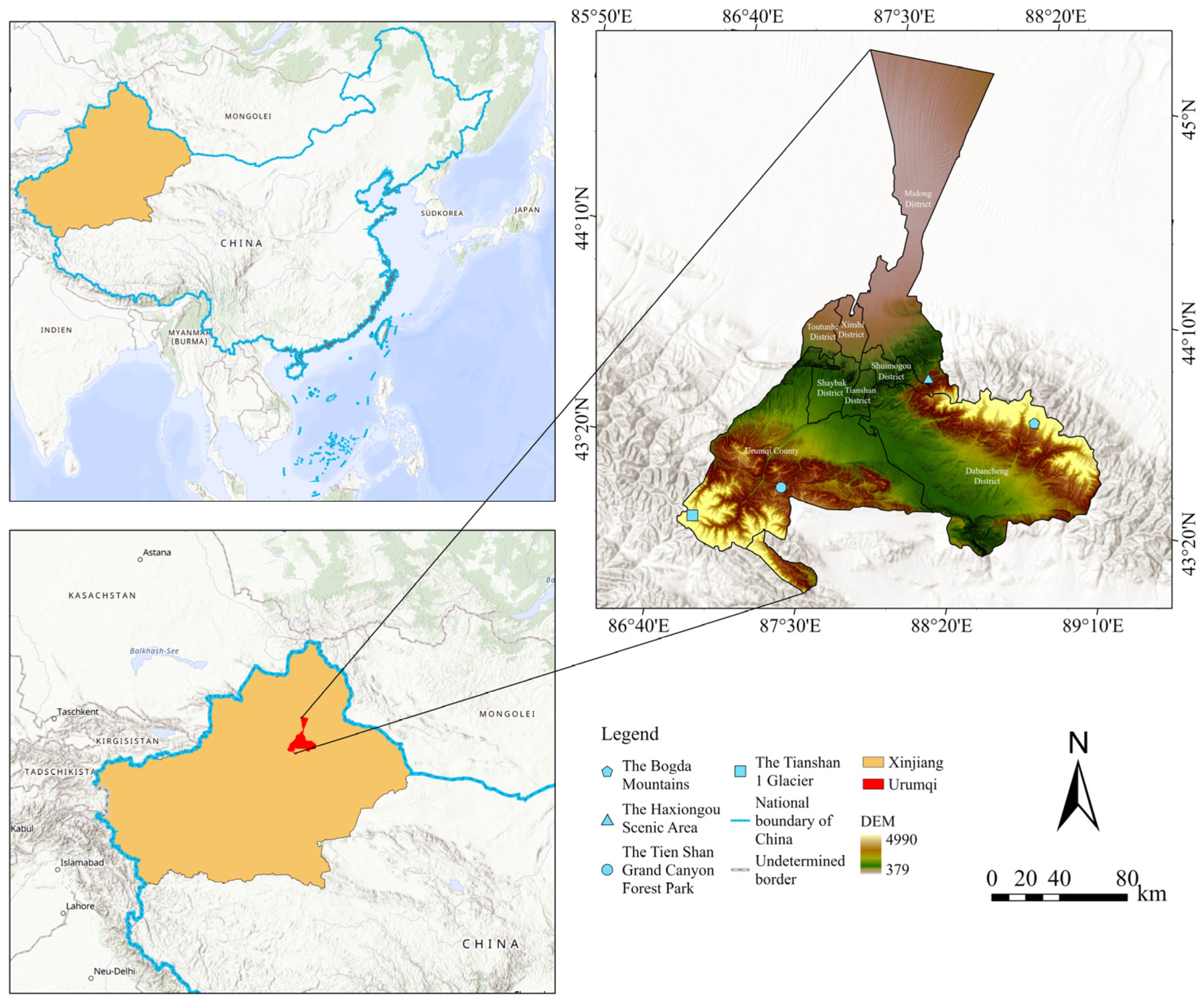
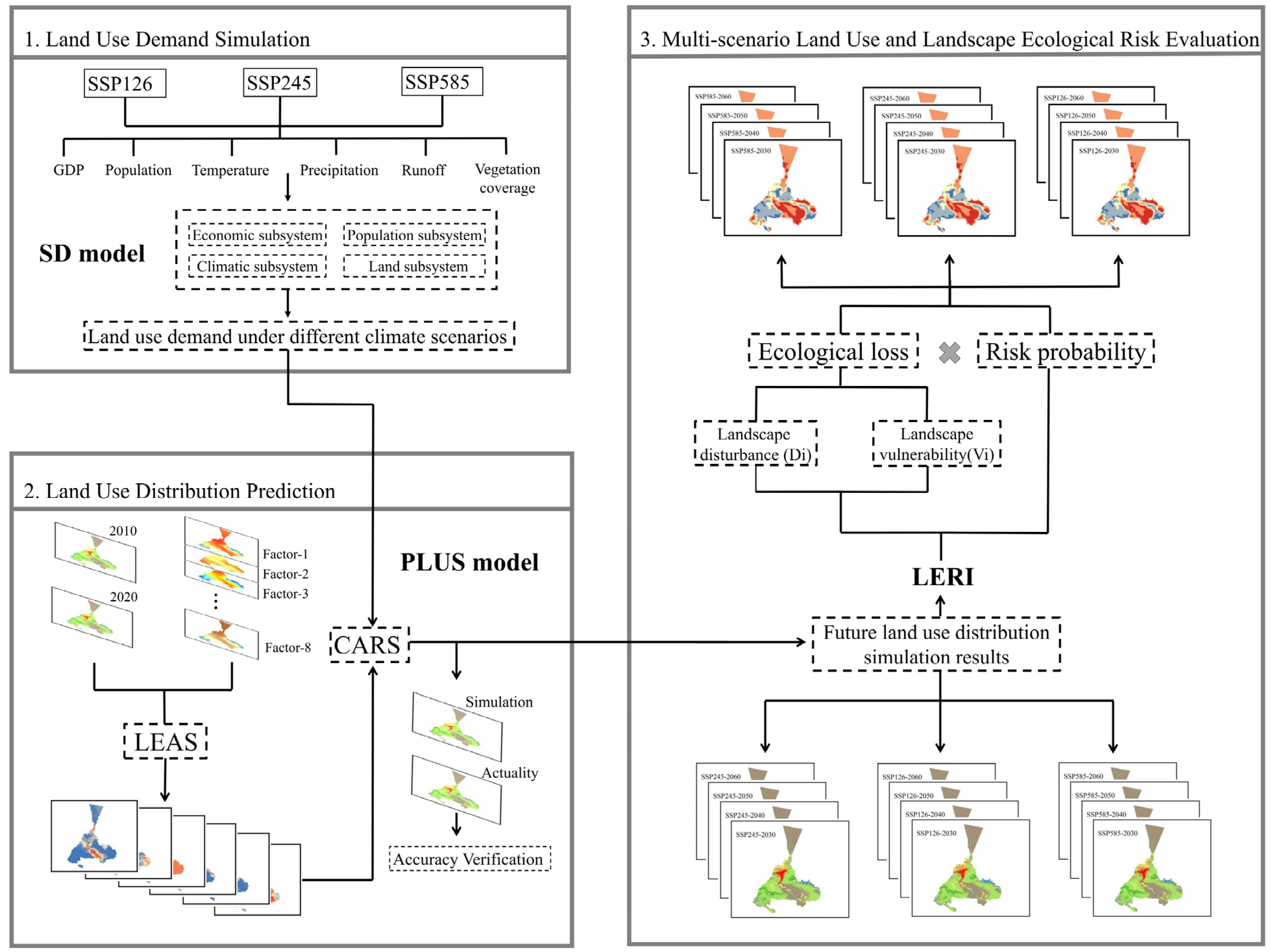
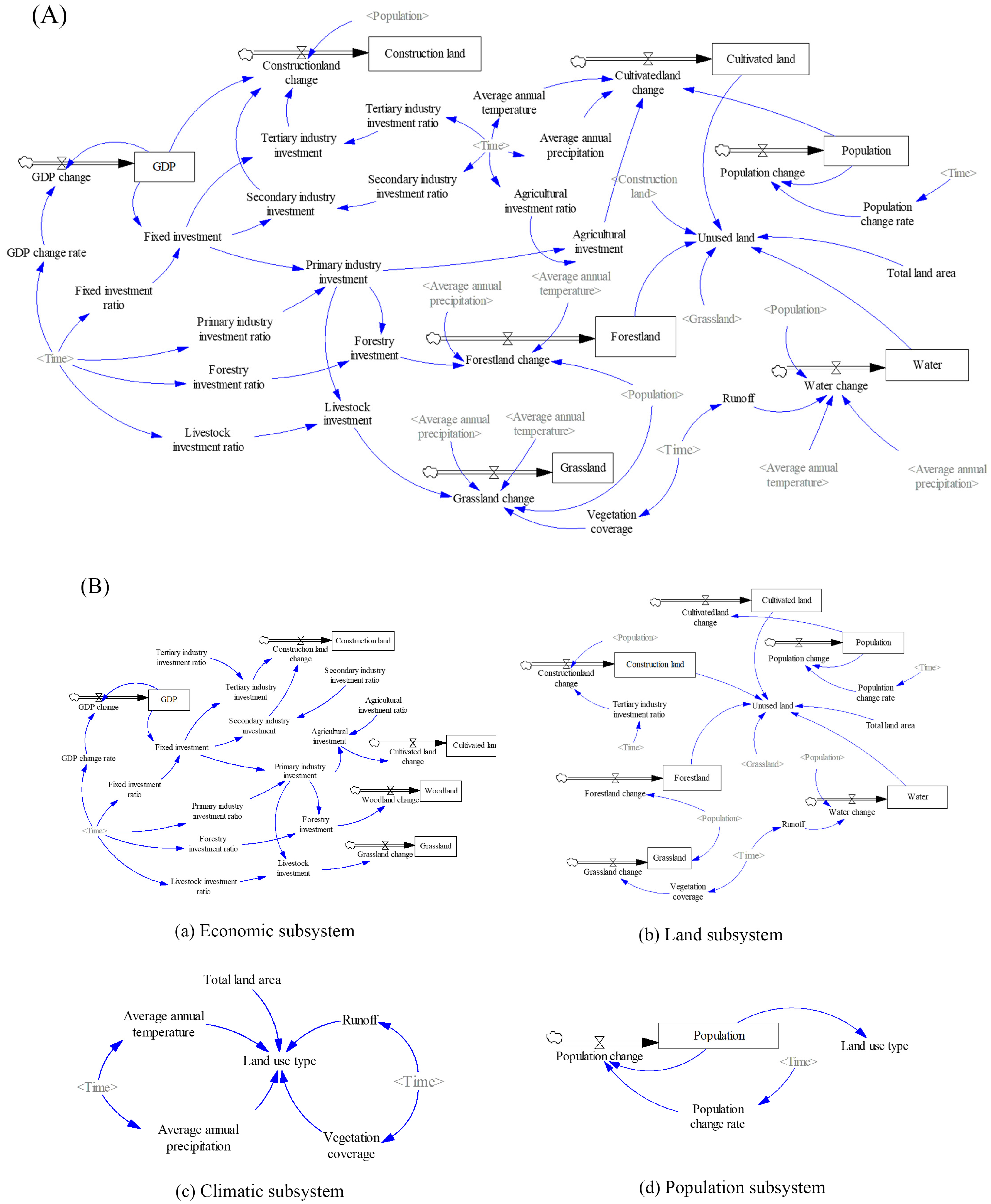
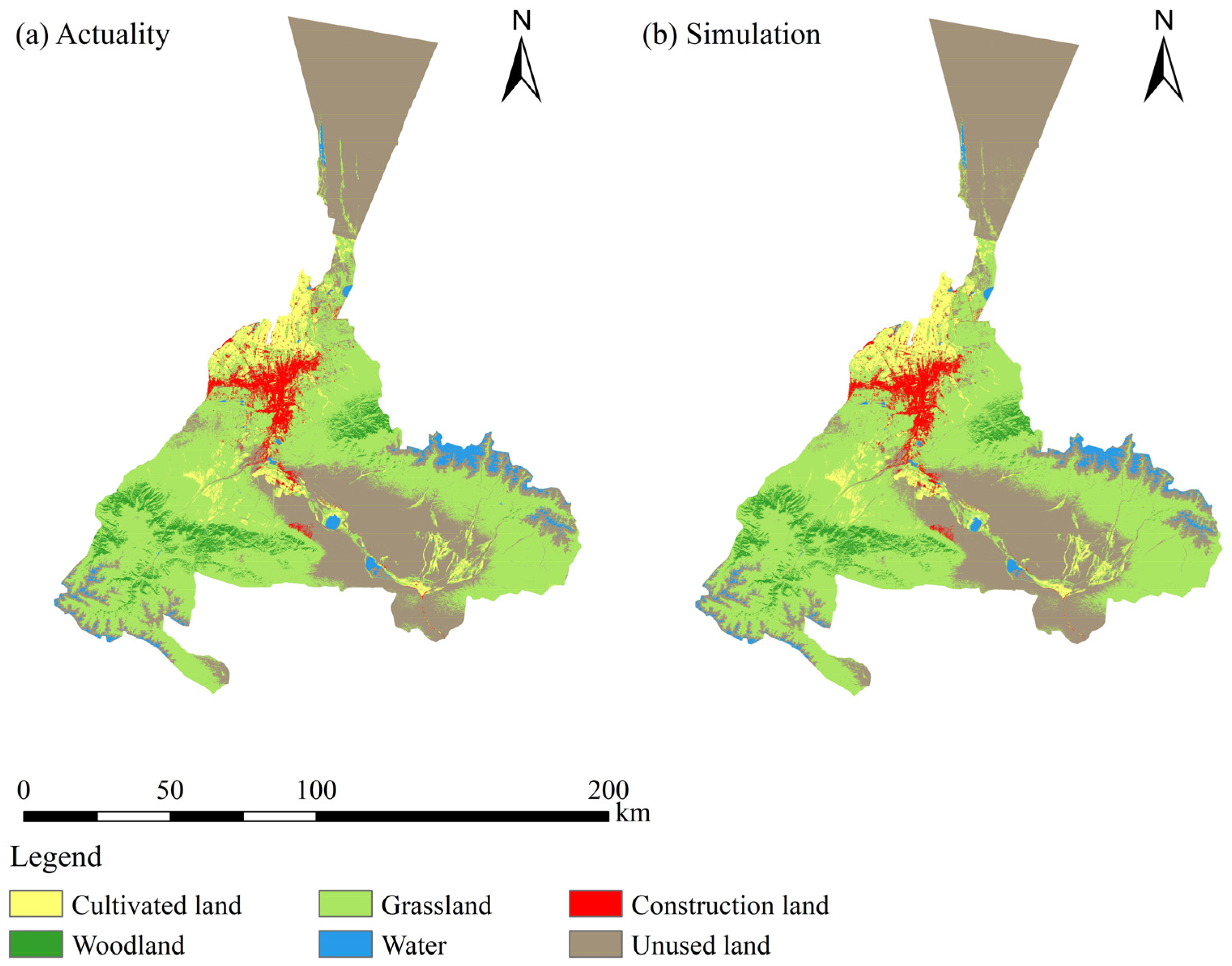
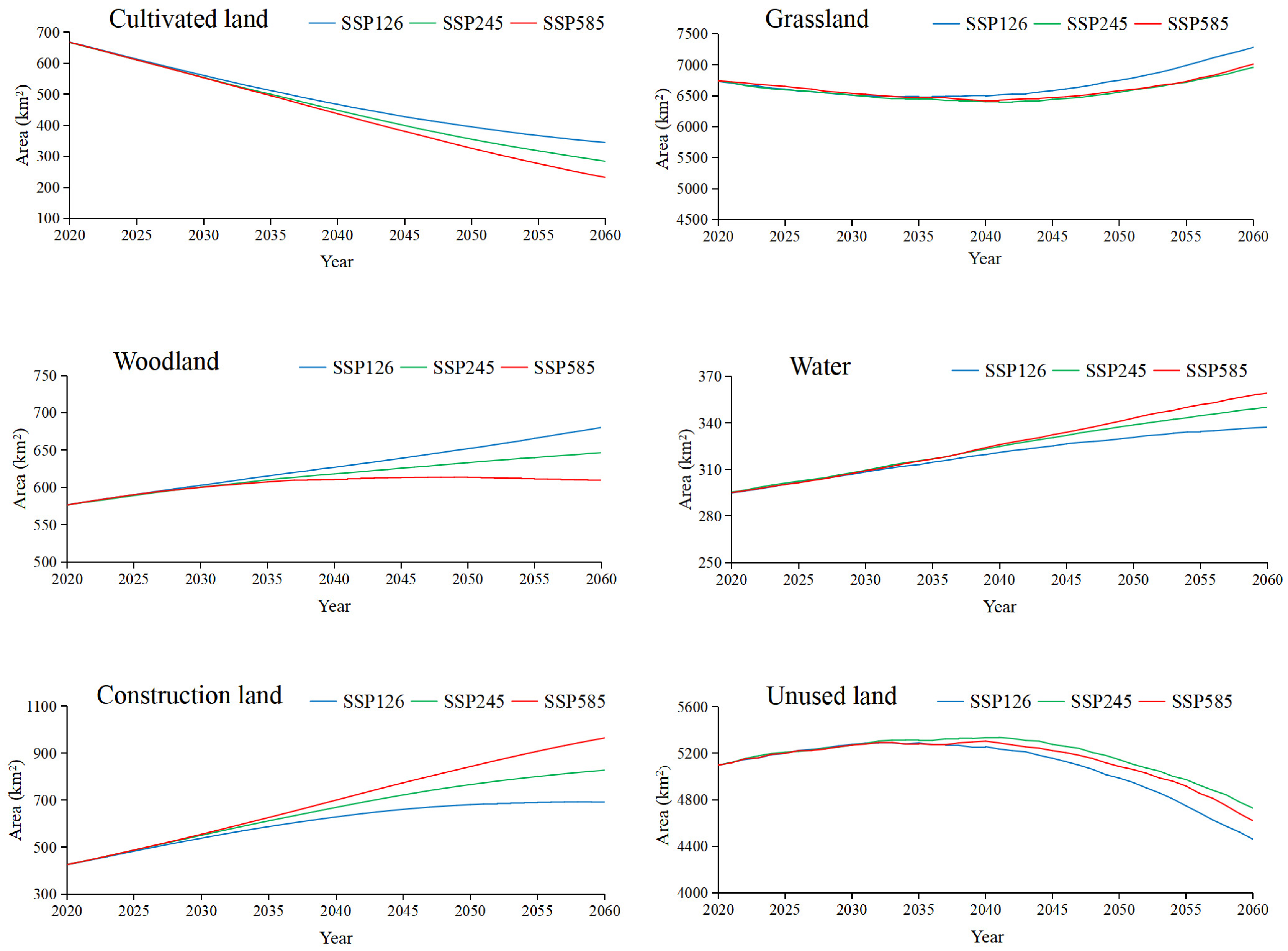
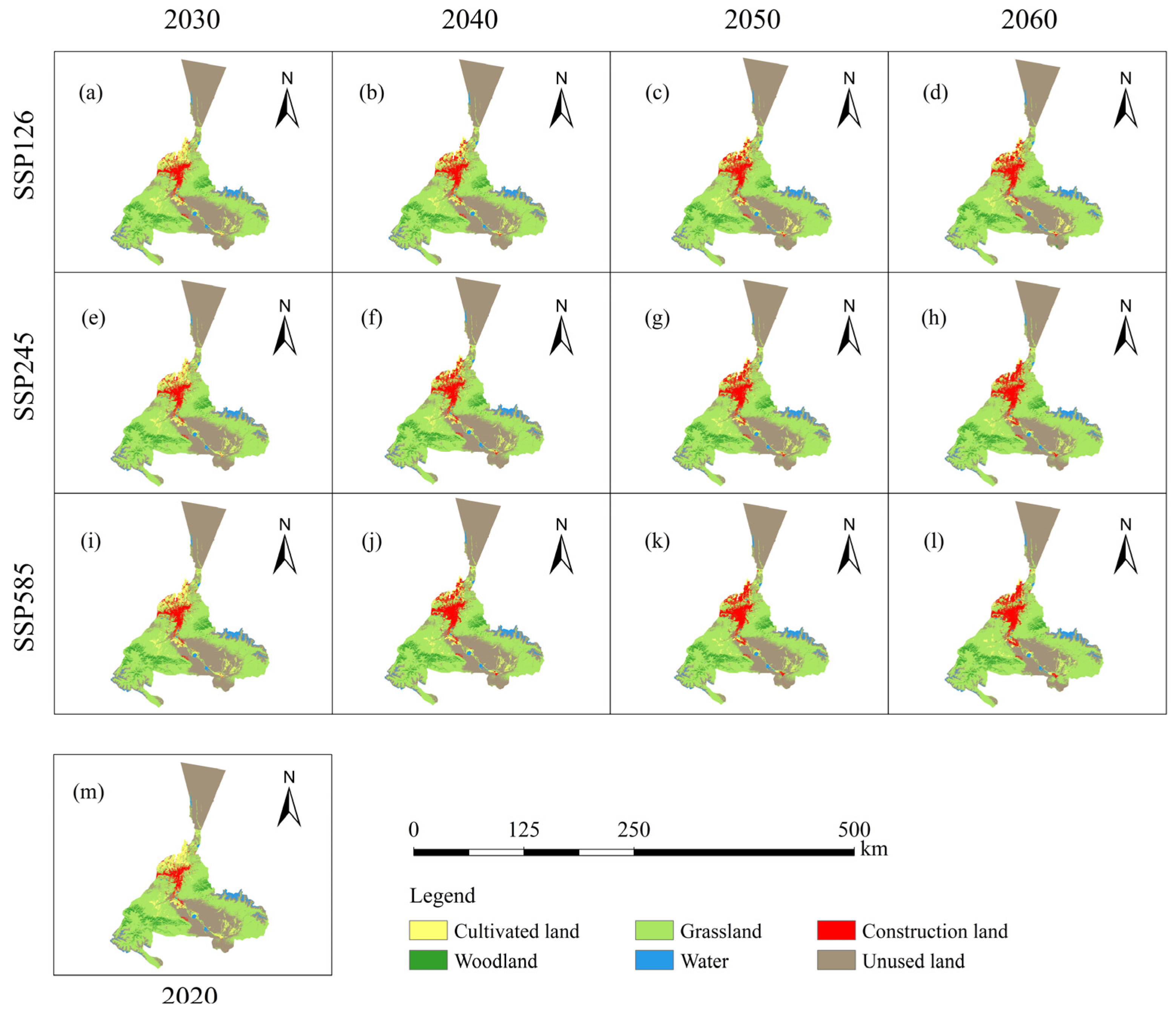
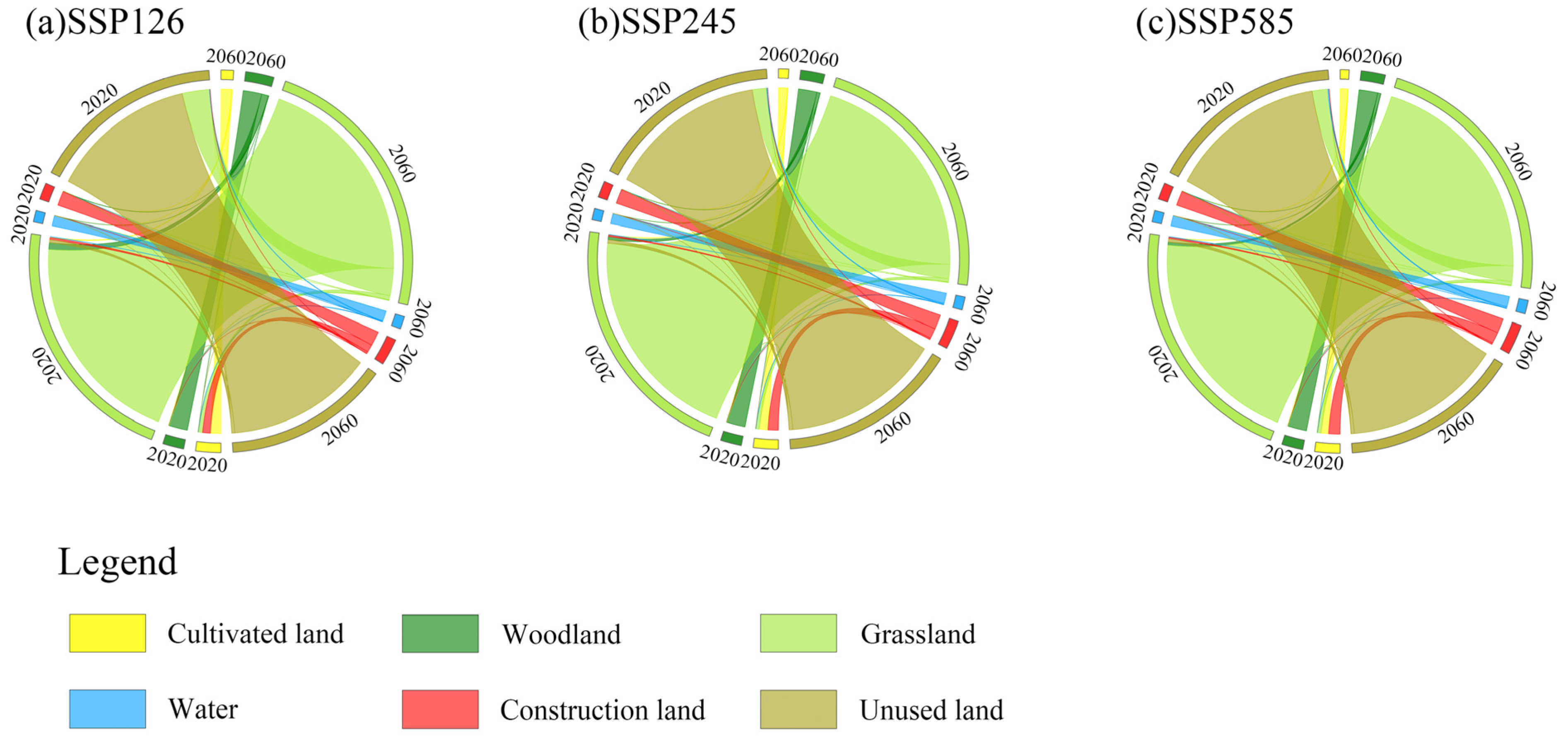
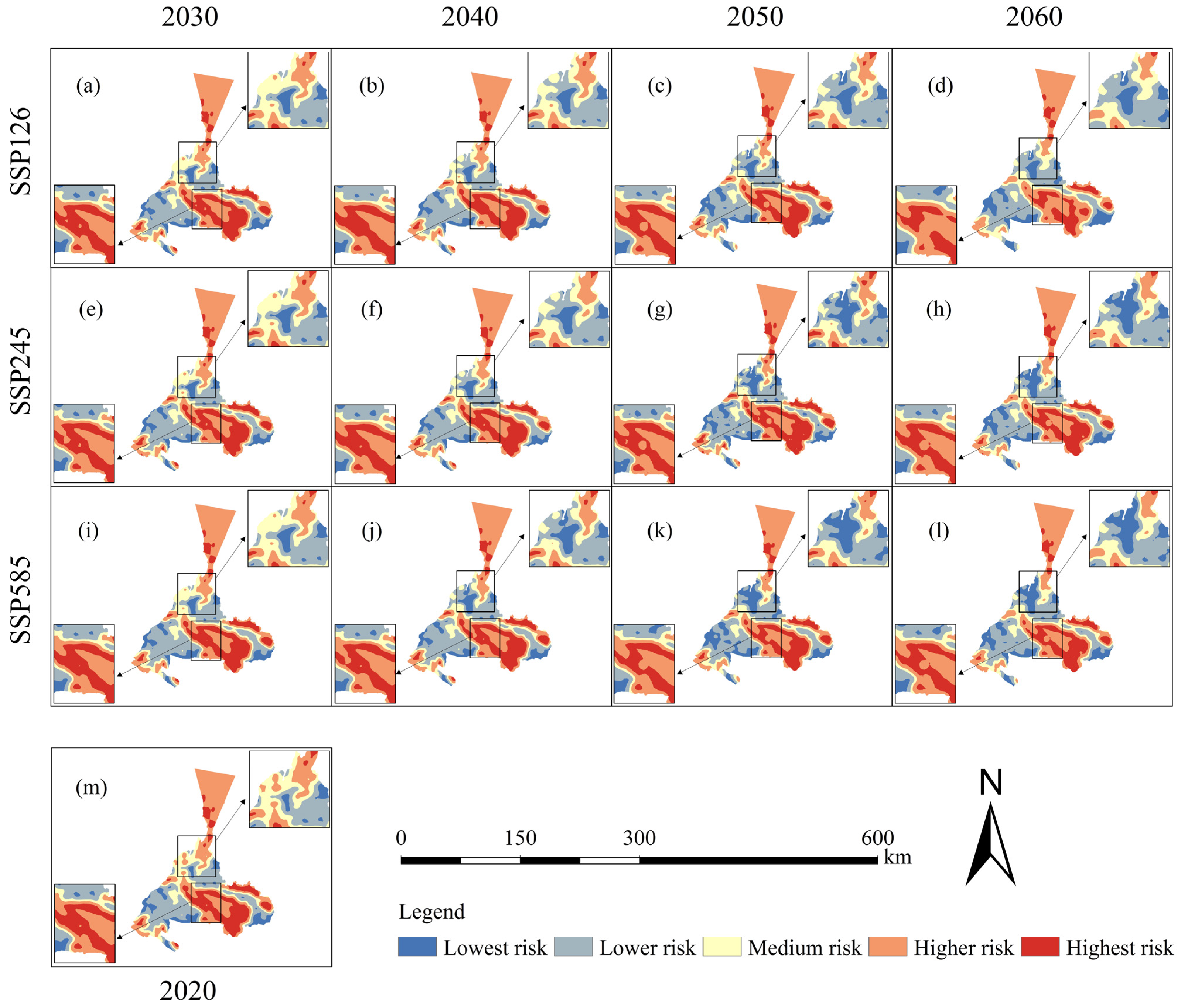
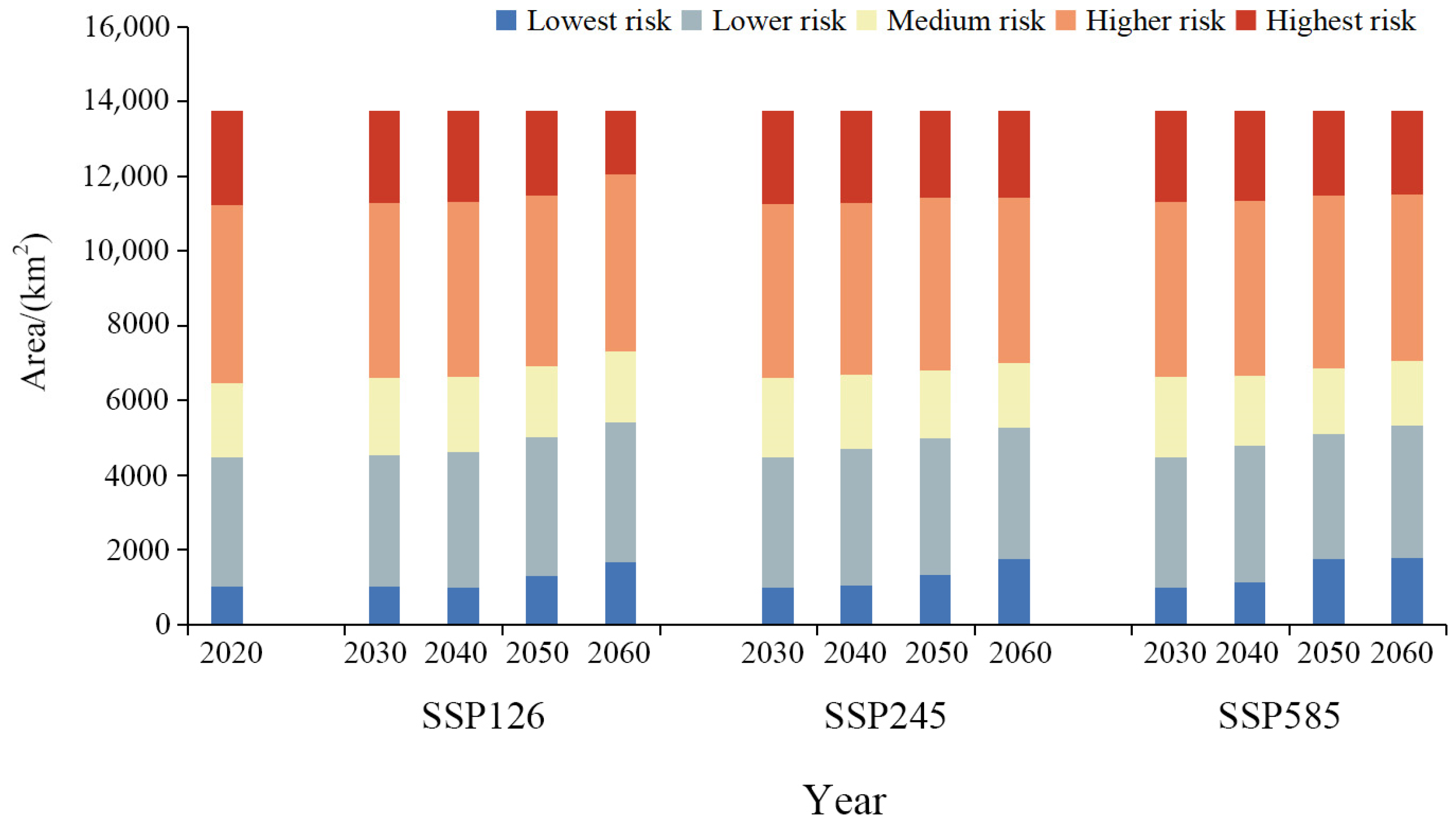

| Scenarios | Description |
|---|---|
| SSP126 | This scenario is a combination of SSP1 and RCP2.6 and represents a low-GHG-emitting sustainable development scenario with significant land use change [42]. In it, the global average temperature in 2100 will not increase by more than 2 °C relative to pre-industrial levels, and the radiative forcing will stabilize at 2.6 W/m2. |
| SSP245 | This scenario is a combination of SSP2 and RCP4.5 and represents a medium development scenario with moderate GHG emissions, which is representative of maintaining the current rate of socio-economic development and level of scientific and technological development [43]. It shows a global average temperature increase of 2–3 °C in 2100 relative to pre-industrial levels and a stable radiative forcing of 4.5 W/m2. |
| SSP585 | This scenario is a combination of SSP5 and RCP8.5 and indicates a fast-track development scenario with high GHG emissions (large-scale use of conventional fossil fuels). Under this scenario, the global average temperature in 2100 will rise by more than 4 °C relative to pre-industrial levels, and the radiative forcing will be as high as 8.5 W/m2. SSP5 is the only shared socio-economic pathway that enables radiative forcing up to 8.5 W/m2 [42]. |
| Land Use Type | Simulated Value in 2020 (km2) | Actual Value in 2020 (km2) | Relative Error (%) |
|---|---|---|---|
| Cultivated land | 668.10 | 641.55 | 4.14% |
| Woodland | 574.10 | 560.80 | 2.37% |
| Grassland | 6776.00 | 6875.58 | −1.45% |
| Water | 293.40 | 288.05 | 1.86% |
| Construction land | 413.70 | 421.24 | −1.79% |
| Unused land | 5069.00 | 5007.30 | 1.23% |
| Parameter Type | RGG (%) | RPG (%) | TC (°C) | PC (mm) | RV (mm) | VC (%) | |
|---|---|---|---|---|---|---|---|
| 2020–2030 | SSP126 | 44.86 | 6.1 | 0.59 | −14.23 | −1.14 | 0.002 |
| SSP245 | 41.46 | 8.31 | 0.48 | −6.15 | 7.39 | 0.050 | |
| SSP585 | 45.9 | 6.89 | 0.7 | 15.06 | 7.74 | −0.006 | |
| 2030–2040 | SSP126 | 39.04 | 4.63 | 0.38 | −2.05 | −10.18 | 0.001 |
| SSP245 | 37.99 | 6.79 | 0.83 | 19.77 | 12.1 | −0.053 | |
| SSP585 | 44.25 | 5.51 | 0.93 | −12.45 | −6.4 | 0.000 | |
| 2040–2050 | SSP126 | 29.68 | 2.7 | 0.43 | −5.41 | 8.29 | 0.000 |
| SSP245 | 35.42 | 5.71 | 0.46 | −1.67 | −16.04 | −0.039 | |
| SSP585 | 38.52 | 3.53 | 0.84 | 3.04 | 20.02 | 0.000 | |
| 2050–2060 | SSP126 | 17.21 | 0.85 | 0.14 | 15.11 | 0.24 | −0.001 |
| SSP245 | 21.96 | 4.47 | 0.62 | −8.36 | −2.88 | −0.046 | |
| SSP585 | 28.05 | 1.74 | 0.66 | 8.35 | −14.55 | 0.000 | |
| Index | Formula | Meaning of Formulas and Description of Parameters |
|---|---|---|
| Landscape fragmentation () | Indicates the fragmentation and instability of landscape patches in a certain space–time, where is the number of patches of a landscape type and is the total area of a landscape type. | |
| Landscape Separation () | Reflects the individual dispersion of landscape patches, where is the total area of the region. | |
| Landscape fractal dimension () | Measures the complexity of morphological changes when landscape patches are disturbed, where is the number of samples in which patch i occurs/total number of samples, is the number of patch i/total number of patches, and is the area of patch i/total area of samples. | |
| Landscape disturbance () | Reflects the resistance of the landscape to the disturbance of external factors, where , , and are the weights of , , and , respectively, based on previous studies and expert opinions [52], and , , and are set to 0.5, 0.3, and 0.2, respectively. | |
| Landscape vulnerability () | Set up according to actual situation of the local landscape. | Reflects the sensitivity and vulnerability of the landscape to the disturbance of external factors. Referring to related studies and combining with the actual situation of Urumqi [50], the values of unused land, water, cultivated land, grassland, woodland, and construction land are given, respectively, as 6, 5, 4, 3, 2, and 1, and normalized. |
| Land Use Type | 2020 | SSP126 | SSP245 | SSP585 | |||||||||
|---|---|---|---|---|---|---|---|---|---|---|---|---|---|
| 2030 | 2040 | 2050 | 2060 | 2030 | 2040 | 2050 | 2060 | 2030 | 2040 | 2050 | 2060 | ||
| Cultivated land (km2) | 641.6 | 560.7 | 467.2 | 395.1 | 344.5 | 554.2 | 447.8 | 355.2 | 283.7 | 552.9 | 436.8 | 326.3 | 231.5 |
| Woodland (km2) | 560.8 | 602.8 | 626.9 | 652.4 | 680.3 | 600.3 | 618.1 | 633.2 | 646.8 | 600.6 | 610.9 | 613.5 | 609.1 |
| Grassland (km2) | 6875.6 | 6509.1 | 6495.4 | 6750.6 | 7280.3 | 6509.1 | 6402.2 | 6556.4 | 6958.1 | 6537.5 | 6417.2 | 6582.6 | 7010.3 |
| Water (km2) | 288.1 | 308.4 | 321.1 | 330.7 | 337.3 | 309.5 | 324.9 | 338.7 | 350.3 | 309.2 | 326.1 | 343.1 | 359.4 |
| Construction land (km2) | 421.2 | 538.2 | 628.6 | 680.6 | 690.6 | 550.6 | 668.9 | 765.7 | 827.7 | 555.8 | 699.6 | 842.8 | 964.4 |
| Unused land (km2) | 5007.3 | 5275.3 | 5256.4 | 4986.1 | 4461.3 | 5270.1 | 5332.1 | 5145 | 4728 | 5240.5 | 5303.7 | 5086.2 | 4620.1 |
Disclaimer/Publisher’s Note: The statements, opinions and data contained in all publications are solely those of the individual author(s) and contributor(s) and not of MDPI and/or the editor(s). MDPI and/or the editor(s) disclaim responsibility for any injury to people or property resulting from any ideas, methods, instructions or products referred to in the content. |
© 2023 by the authors. Licensee MDPI, Basel, Switzerland. This article is an open access article distributed under the terms and conditions of the Creative Commons Attribution (CC BY) license (https://creativecommons.org/licenses/by/4.0/).
Share and Cite
Fan, H.; Si, Q.; Dong, W.; Lu, G.; Liu, X. Land Use Change and Landscape Ecological Risk Prediction in Urumqi under the Shared Socio-Economic Pathways and the Representative Concentration Pathways (SSP-RCP) Scenarios. Sustainability 2023, 15, 14214. https://doi.org/10.3390/su151914214
Fan H, Si Q, Dong W, Lu G, Liu X. Land Use Change and Landscape Ecological Risk Prediction in Urumqi under the Shared Socio-Economic Pathways and the Representative Concentration Pathways (SSP-RCP) Scenarios. Sustainability. 2023; 15(19):14214. https://doi.org/10.3390/su151914214
Chicago/Turabian StyleFan, Haoran, Qi Si, Wenming Dong, Gang Lu, and Xinping Liu. 2023. "Land Use Change and Landscape Ecological Risk Prediction in Urumqi under the Shared Socio-Economic Pathways and the Representative Concentration Pathways (SSP-RCP) Scenarios" Sustainability 15, no. 19: 14214. https://doi.org/10.3390/su151914214
APA StyleFan, H., Si, Q., Dong, W., Lu, G., & Liu, X. (2023). Land Use Change and Landscape Ecological Risk Prediction in Urumqi under the Shared Socio-Economic Pathways and the Representative Concentration Pathways (SSP-RCP) Scenarios. Sustainability, 15(19), 14214. https://doi.org/10.3390/su151914214





